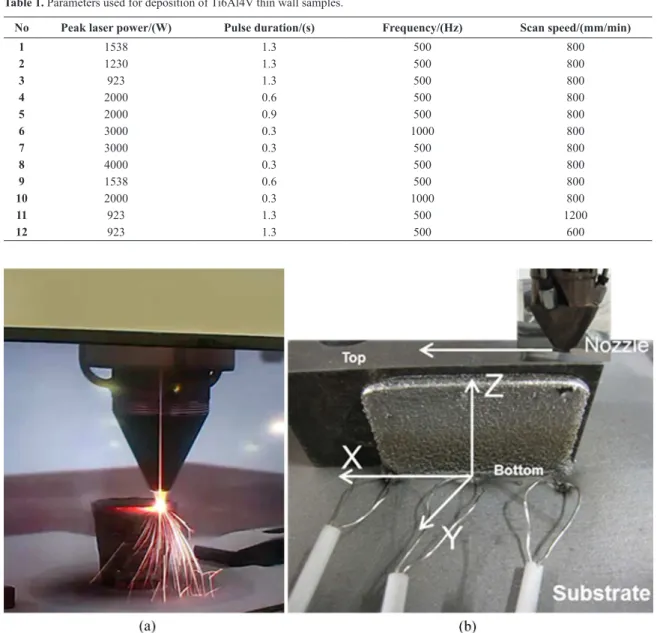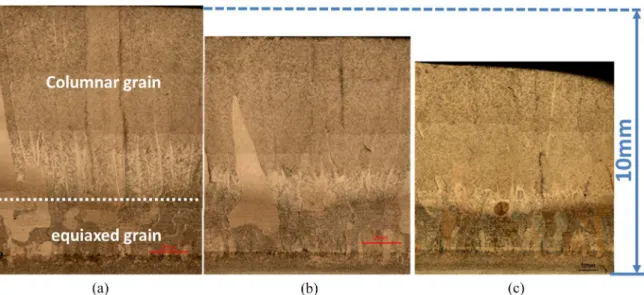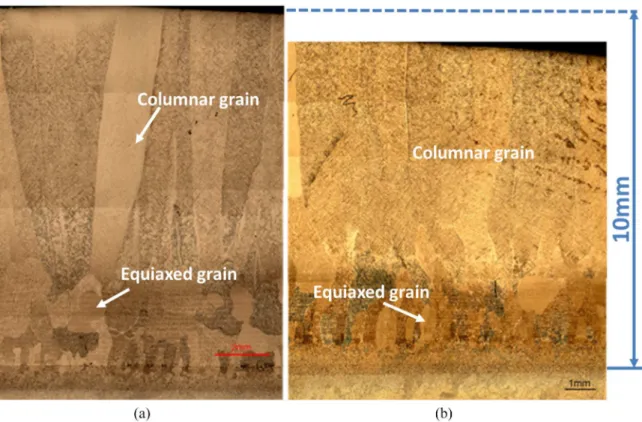*e-mail: hyuf1@hotmail.com
1. Introduction
Additive manufacturing is a relative novel idea to fabricate complex, net-shaped metal components in successive layers1. Direct laser deposition is one of the additive manufacturing techniques for metals which are currently under investigation2. In this method, the shaped part is produced using a CAD ile to move the nozzle in the XY-plane and the powder feed in three angles to Z-direction to add successive layers. Recently, a lot of studies have been done on the direct laser deposition which showed the signiicant effect of the laser parameters such as laser powder, scanning speed and duration time, etc3-8. Kruth et al.3 studied the processing window, including the selection of appropriate scan patterns, for a mixture of different types of metal powder particles. It was found that intermediate range parameters produced suficient remelting of the previous layer. Yadroitsev et al.4 studied the effect of laser power and scanning speed on the proile of melted or deposited lines of Inox904L steel powder using Phoenix machine, and it was found that 120 μm was the optimum hatch distance in terms of porosity, and little difference was found in the tensile properties of the samples. Nowadays, there are several reports published regarding additive manufacturing of metals using powder, e.g. those from the Monash University5, University of Birmingham6-8, Northwestern Polytechnical University9, Beihang University10 and NASA Langley Research Center11, etc. From these previously reported papers, it could be seen that these studies are mainly concentrated with the equipment, the laser software and the relationship between single laser parameter and the properties of materials. More work is still required to understand the microstructure development during the direct laser process and the relationship between the
process parameters and the microstructure of the deposited parts. In this paper, a powder-feed laser based process was used for the manufacture of Ti6Al4V samples. The effect of laser deposition parameters on the microstructure of additive layer manufactured Ti6Al4V was investigated.
2. Experimental
The materials used in this study are Ti6Al4V powder particles with size of 100~200 μm in diameter. 5 mm thin plate was used as a substrate, which was cut from cast Ti6Al4V block using electrical discharge machining (EDM) machine. The surface was ground with 320 grit SiC paper, and cleaned with ethanol before the deposition. A TRUMPF DLD (blown powder) system itted with 4KW disc laser has been used to fabricate Ti6Al4V samples. The spacing between the nozzle tip and the substrate was set up as 16 mm which will give rise to certain build layer thickness for speciic sample. Thin wall Ti6Al4V samples of 20 mm in length, 10 mm in height and 4 mm in thickness are built by multilayer deposition in this study. The deposition process was carried out in an argon atmosphere with O2<20 ppm, titanium powders were fed through three beam nozzles into the laser focus point. The laser fabrication parameters used in this study are listed in Table 1. The Z-incensement is 0.12 mm in all the samples examined in this paper. Samples with different parameters are cut along longitudinal direction including the Ti6Al4V substrate. All the samples were ground, polished and etched for optical observation. The effect of the laser power, scanning speed and duration time on microstructure of Ti6Al4V thin wall samples were investigated individually. Figure 1 shows the experiment process and the examples of different shaped components.
Investigation on the Microstructure of Direct Laser Additive Manufactured Ti6Al4V Alloy
Yuanfei Hana,b*, Weijie Lua, Tom Jarvisb, John Shurvintonb, Xinhua Wub
aState Key Laboratory of Metal Matrix Composite, Shanghai Jiao Tong University, Shanghai, 200240, PR China
bARC Centre of Excellence for Design in Light Metals, Monash University, Clayton, Victoria, Australia
Received: September 1, 2014; Revised: October 21, 2015
Direct laser fabrication (DLF) is one of the advanced near-net shape processing technologies. The variations of laser parameters can change the energy distribution within a laser scan, and thus affect the cooling rate, and resulting microstructure of deposited material. In this study, the effect of the laser parameters on the microstructure of additive laser fabricated Ti6Al4V alloy was investigated. It was found that huge columnar grains formed during laser fabrication of Ti6Al4V alloy for a wide range of processing conditions, and the laser power, scanning speed and duration time were had a signiicant effect on the reinement of the prior grains. Gradient morphologies were obtained from a complex thermal history.
3. Results
3.1. Effect of laser power
Figure 2 shows the macrostructure of the pulse laser fabricated Ti6Al4V alloy, which was obtained at various laser powers (923 W, 1230 W and 1538 W). All macrographs are shown in longitudinal direction, it should be noted that this alloy tends to form large columnar growth prior β grains under most laser deposition process. The morphology of β grain has been changed obviously with increasing the laser power, the size of the columnar grains in individual samples varies from the edge to the center and from the bottom to the top (Figure 1a). By increasing the laser power, the length of the columnar grains becomes shorter, and the equiaxied grain also has been obtained. Although a few small equiaxed grains obtained at the bottom of the sample built with a power of 1538 W, the height of this region is normally less than 2 mm. It is also noted that samples cannot be built with
a very high laser power (>1538 W). For example, a sample fabricated with laser power of 1538 W, the deined sample height is 10 mm and Z-increment is 0.12 mm, but the actual height obtained is only 7 mm.
3.2. Effect of laser scanning speed
Figure 3 shows the effect of laser scanning speed on the grain microstructure of the laser built sample. The experiment were conducted at the same heat input conditions, it means keeping frequency, laser power and other laser parameters constant to guarantee the input energy. It can be clearly seen that for a given laser power and frequency, the huge columnar grains became broadened with an increase of laser scanning speed. The maximum grain width could reach 2.5 mm. It was also noted that the morphology of the prior β grains has no signiicant difference with those samples deposited at slow scanning speed, and there are some layer bands in all examined samples. The thickness of the layer band normally reduced Table 1. Parameters used for deposition of Ti6Al4V thin wall samples.
No Peak laser power/(W) Pulse duration/(s) Frequency/(Hz) Scan speed/(mm/min)
1 1538 1.3 500 800
2 1230 1.3 500 800
3 923 1.3 500 800
4 2000 0.6 500 800
5 2000 0.9 500 800
6 3000 0.3 1000 800
7 3000 0.3 500 800
8 4000 0.3 500 800
9 1538 0.6 500 800
10 2000 0.3 1000 800
11 923 1.3 500 1200
12 923 1.3 500 600
and gradually disappeared at the top of the samples. It also decreased with the increasing scanning speed (Figure 3c). Moreover, it is dificult to build a deined size sample when the scanning speed is much higher (>1200 mm/min). The actual height of the sample was only approximately 5 mm at scanning speed of 1200 mm/min (Figure 3c).
3.3. Effect of laser duration time
In order to investigate the macrostructure affected by the pulse duration time, short and long duration time are used to deposit samples at laser power of 2000 W, keeping the frequency of 500 Hz and the scanning speed of 800 mm/min. The samples deposited at different duration time are shown in Figure 4. Figure 4a, b are deposited for 0.6 s and 0.9 s,
respectively. It was found that the duration time had great effect on the prior β grains. Huge columnar grains were observed with both short and long duration time. With an increase of duration time from 0.6 s to 0.9 s, the huge columnar grains became shorter and smaller, and the height of the build was lower than the sample built at short duration time.
4. Discussion
During the direct laser fabricated process of Ti6Al4V alloy thin wall, it is found that the huge columnar grains are easily obtained. We have not found any effective method to achieve grain reinement by changing the laser deposition parameters. There are only a few smaller equiaxed grains Figure 2. Montage of macrostructure of pulse laser deposition Ti6Al4V thin wall showing large columnar growth prior β grains with
laser power of 923 W (a); 1230 W (b); 1538 W (c). (Frequency is 500 HZ, scanning speed is 800 mm/min, and average laser power is 600 W (a); 800 W (b); 1000 W (c)).
Figure 3. Montage of macrostructure of pulse laser deposition Ti6Al4V thin wall showing large columnar growth prior β grains with
which could be found at the bottom of the deposit. The reason should be related to the higher cooling rate. Once the laser passes the Ti6Al4V substrate, the Ti6Al4V substrate should be heated up to the liquids temperature in the heat affect zone, some small equiaxed grains could grow when the temperature exceed β transus temperature, these small β grains will provide idea nucleation sites, it quickly grows into the melt pool. The growing grain forms as a continuation of another grain in the interface of the substrate. This process is known as epitaxial grain growth. By adding another layer, the β grains continue to nucleate and grow from the previous β grains. This process could cause a columnar growth as described in Figure 5 and metallurgical observation in Figure 2, Figure 3 and Figure 4, respectively. In order to reine the grain size, it’s necessary to increase the heterogeneous nucleation. For this direct laser fabrication, more Ti6Al4V powders will be ejected into the melt pool by keeping the laser power constant, reducing the scanning speed and increasing the duration time. So more nucleation sites can block the columnar grain growth, the grains can be reined by reducing the scanning speed and increasing the duration time. Meanwhile, the built height is different for the changes of laser processing parameters. It seems to have decreased slightly with increasing laser power, scanning speed and duration time. The result is convincible because, assuming an excess of power, scanning speed and duration time, more powders will be melted as more energy is absorbed, resulting in thicker and wider layers.
If the melt pool solidiies quickly, the time available for poor spreading would be small. Therefore, a thicker layer and lower height would be obtained.
Figure 5. Schematic diagram of epitaxial grain growth of additive deposition of Ti6Al4V sample.
Figure 4. Montage of macrostructure of pulse laser deposition Ti6Al4V thin wall showing large columnar growth prior β grains with
5. Conclusion
The microstructure of the additive laser fabricated Ti6Al4V affected by pulsed laser parameters has been systematically studied. It was found that the laser power, scanning speed, duration time are sensitive on the grain morphology and the dimension of the specimens. Big columnar grains are rather easy to obtain during the direct laser fabricated Ti6Al4V alloy. By reducing the scanning speed, increasing the duration time and laser power, the big columnar grain growth could be blocked and reined. Meanwhile, cooling rate is an important factor in determining the resultant microstructure and build height of the deposited billets. The build height seems to
have decreased with increasing laser power, scanning speed and duration time.
Acknowledgements
We would like to acknowledge the inancial support provided by the National Nature Science Foundation of China (Grant No. 51371114 and 51501112), the 973 Program under Grant No. 2012CB619600, the China Postdoctoral Science Foundation (Grant No. 2014M550235 and 2015T80431), the Shanghai Postdoctoral Sustentation Fund (Grant No. 14R21410900) and the fund of National Engineering and Research Center for Commercial Aircraft Manufacturing (Grant No. SAMC14-JS-15-047).
References
1. Baufeld B, Biest OVD and Gault R. Additive manufacturing of
Ti6Al4V components by shaped metal deposition: microstructure and mechanical properties. Materials & Design. 2010; 31:s106-s111. http://dx.doi.org/10.1016/j.matdes.2009.11.032.
2. Wu X and Mei J. Near net shape manufacturing of components
using direct laser fabrication technology. Journal of Materials Processing Technology. 2003; 135(2-3):266-270. http://dx.doi. org/10.1016/S0924-0136(02)00906-8.
3. Kruth JP, Froyen L, Van Vaerenbergh J, Mercelis P, Rombouts M and Lauwers B. Selective laser melting of iro-based powder. Journal of Materials Processing Technology. 2004; 149(1-3):616-622. http://dx.doi.org/10.1016/j.jmatprotec.2003.11.051.
4. Yadroitsev I, Bertrand P and Smurov I. Parametric analysis of
the selective laser melting process. Applied Surface Science. 2007; 253(19):8064-8069. http://dx.doi.org/10.1016/j. apsusc.2007.02.088.
5. Rometsch PA, Zhong H, Nairn KM, Jarvis T and Wu X. Characterization of a laser fabricated hypereutectic Al-Sc
alloy bar. Scripta Materialia. 2014; 87:13-16. http://dx.doi. org/10.1016/j.scriptamat.2014.05.021.
6. Wang F, Mei J and Wu X. Direct laser fabrication of Ti6Al4V/
TiB. Journal of Materials Processing Technology. 2008; 195(1-3):321-326. http://dx.doi.org/10.1016/j.jmatprotec.2007.05.024.
7. Qiu CL, Ravi GA and Attallah MM. Microstructure control duing direct laser deposition of a β-titanium alloy. Materials & Design. 2015; 81:21-30. http://dx.doi.org/10.1016/j.matdes.2015.05.031.
8. Qiu CL, Ravi GA, Dance C, Ranson A, Dilworth S and Attallah
MM. Fabrication of large Ti6Al4V structures by direct laser deposition. Journal of Alloys and Compounds. 2015; 629:351-361. http://dx.doi.org/10.1016/j.jallcom.2014.12.234.
9. Hua T, Jing C, Fengying Z, Xin L and Weidong H. Microstructure
and mechanical properties of laser solid formed Ti6Al4V from blended elemental powders. Rare Metal Materials and Engineering. 2009; 38(4):574-578. http://dx.doi.org/10.1016/ S1875-5372(10)60028-8.
10. Tian XJ, Zhang SQ and Wang HM. The influences of anneal
temperature and cooling rate on microstructure and tensile properties of laser deposited Ti4Al1.5Mn titanium alloy.
Journal of Alloys and Compounds. 2014; 608:95-101. http:// dx.doi.org/10.1016/j.jallcom.2014.04.058.
11. Taminger KMB and Hafley RA. RTO-MP-AVT-139 - Cost effective manufacture via net shape processing. In: AVT-139


